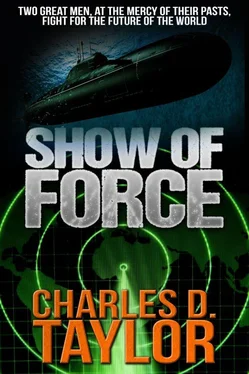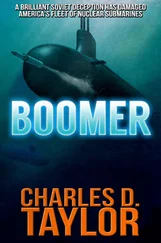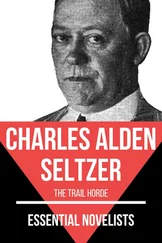Bluefish positioned herself well away from the Soviet fleet, keeping deep enough to avoid any type of airborne detection. At precisely 0630 her commanding officer sent his crew to battle, stations. His sonar operator had identified the antisubmarine cruiser Kronstadt, a sister ship of Marshal Timoshenko, which had been sunk two days before. The computer, of course, had analyzed the sound that had traveled almost two-hundred miles underwater to the listening devices aboard the submarine. The surface ship's sounds were isolated by the computer for the attack console, which fed continuous information concerning the course and speed into the number-three torpedo tube. That tube contained a Tomahawk missile.
At 0700, exactly as Admiral Charles had ordered, Bluefish ejected the missile from number-three tube. Upon breaking the surface of the ocean, and righting itself, the engine ignited. The missile climbed to its selected altitude and achieved maximum speed, leveling its flight according to the information previously programmed into it. It knew exactly where Kronstadt would be in the less than ten minutes it would take to reach its target.
Fifty miles to the northeast, but much closer to the enemy ships because of her shorter range Harpoons, Philadelphia was following the same pattern of target acquisition. She selected a guided-missile destroyer, Boiky, one of the outer circle of ships defending against possible air attack on Lenin. On the opposite side of the Russian fleet, Los Angeles and Archerfish were accomplishing much the same, although Los Angeles was much closer to her targets, since she, too, was utilizing the shorter range Harpoon.
The electronic warfare unit aboard Grozny, a Soviet cruiser selected by Archerfish, gave the initial warning. A bored technician had been quietly scanning the frequency bands when he happened on 'to the acquisition radar of the approaching missile. He quickly flipped the switch that started a computer to identifying the source of the enemy signal. Within a split second it had identified the Tomahawk missile. Alarm bells went off at the same time Gronzy's radar automatically began searching on the Assigned sector for the missile. But it was too late. The launcher that was selected was unable to fire before the Tomahawk warhead's one-thousand pounds of high explosive detonated slightly below and abaft the bridge level, destroying the starboard side of the bridge, and ripping a jagged hole into the room where the no-longer-bored technician unfortunately still sat. For an instant, he realized that the early warning system was not as fast as he had been instructed it was at school. But before he could even cry out this injustice, the force drove his equipment into his body, tearing him from his seat and hurling him the width of the small room that was shattering as he died. 'For pedoes in the tubes forward of the bridge exploded, lifting the forward missile launchers clear of the ship. In less than two seconds, Grozny's bow was a mass of flames, sweeping back to midships as she still plunged ahead at twenty-four knots.
Kronstadt was luckier. It was taking just enough longer for the missile fired in her direction to arrive. She was able to locate the incoming weapon and direct both antimissile and 76-mm. fire at the attacker. A shell explosion close by the Tomahawk caused its direction to deviate slightly as it dove, enough so that it exploded twenty yards off the beam of the great cruiser. The impact buckled the bulkhead in the forward engine room. The chief of the watch was just making his entry in the log following the bridge's order for all the steam he had. The noise behind him was one he had never heard in all his years in an engine room. He turned to see the bulkhead tearing inward, steam lines closest to the impact already bursting. For an instant, the blast held back the ocean. Then, as the first traces of superheated steam touched him, he saw the water filling the great hole, rushing into his beloved engine room. The high-pressure steam scalded him to death before his feet were even wet. Shrapnel from the explosion set off ammunition in one of the A A gun tubs, destroying the mount and its crew.
Boiky, being much smaller, was unable to survive the direct hit of the smaller missile. Her commanding officer, Nikolai Svedrov, helplessly watched the last couple of hundred yards of the Harpoon's approach. The weapon grew bigger as it fell, and his last thoughts were not about his ship but of his brother. He could not imagine that the Americans could possibly hit Lenin, and at least his brother would be able to tell his family that he died in battle. It occurred to him at the last moment that they might team that Boiky never had time to fire a single gun in her own defense. The five-hundred-pound warhead detonated at the waterline, lifting the ship enough to break its back. The captain was thrown into the side of the pilothouse, his neck snapping instantly. Her stern rapidly lifted into the air as the forward section filled with water. The bow section, streaming burning oil, lost speed while making a slow erratic circle to the left as her crew abandoned ship.
The fourth missile exploded in the after crew's quarters on the cruiser Vladivostok, causing a fire but little damage to the ship's ability to maneuver or fight. ' The explosions were the signals for the close-in submarines to commence their attack.Their torpedoes had ranges of over twenty miles. At forty knots, submerged, they presented a difficult target to a force already taking evasive action, and that was their greatest advantage. Cavale fired four torpedoes, two at a cruiser they had been tracking for some time and two more at what later was identified as Kronstadt. The first ship picked up the torpedo noises immediately, turning down their path, offering as little target as possible.
Kronstadt was not so easily maneuvered nor able to hear the torpedoes in the water. The combination of the water still coming into the forward engine room and the damage-control crews' desperate efforts to stem the flow were her death knell. Those sailors in her after engine room at the instant the torpedo entered probably recognized for a moment what few ever know, the source of their death. The explosion, which is always magnified on a ship from the weight of the water behind it, tore a tremendous hole in the hull, ripping upward to buckle the main deck, and downward to rupture fuel tanks. The ocean now became a part of Kronstadt's engineering spaces, creating an automatic list of almost ten degrees. The fuel from the ruptured tanks caught fire instantly. The second torpedo struck aft of the engine room, disabling the giant steering gear and adding another five degrees to the list. Again water did the rest. Kronstadt was dead in the water, burning, and the fires quickly found their way to one of the magazines in the after section of the ship. Before the first report was made to the bridge, her captain knew he would stay with his ship, but gave his crew the order to abandon.
The submarines dove immediately after firing, their job done. By chance, Mendel Rivers was the last to fire. With their attack commencing at 0700, the missile-firing submarines were allowed a full ten minutes to make their departure. Those close in were to take advantage of the confusion that always follows a surprise attack. However, at 0700 Lenin had also launched her first flight of Rigas, and she had helicopters in plane guard station. At the first alarm, the helos left those stations and were vectored to the attacking subs by those ships lucky enough not to be targets.
The sonar operator on Rivers heard the sonobuoys hit the water and reported them immediately to his captain. The attack could not be halted. Rivers's CO, having no more combat experience than any of the others, completed his attack but was late in taking evasive action. The attack console in the Soviet helicopter quickly located the undersea craft and two homing torpedoes were dropped into the water at close enough range so 18ft
Читать дальше












